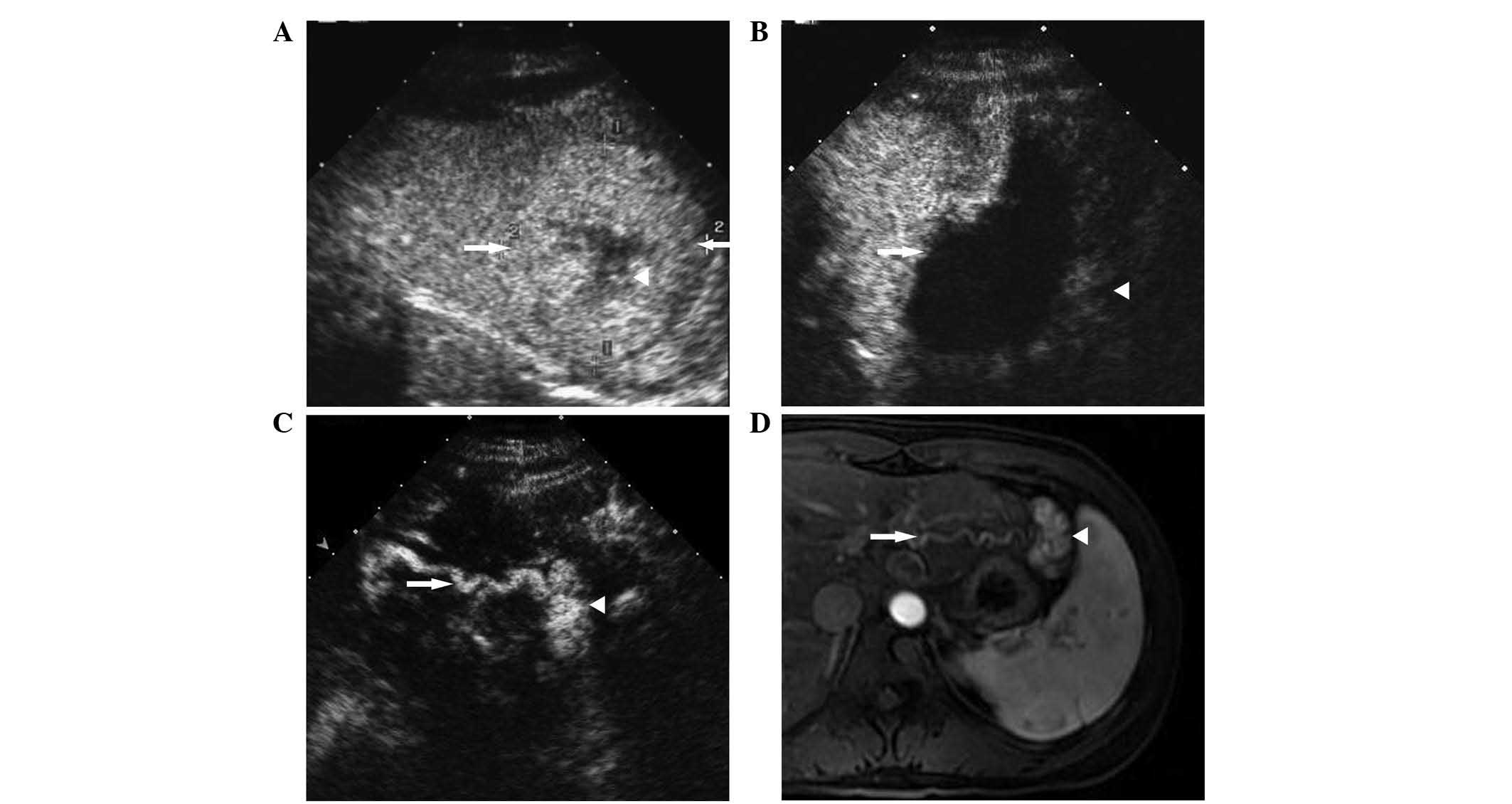|
1
|
Bartolotta TV, Midiri M, Galia M, Rollandi
GA, Cademartiri F, Lagalla R and Cardinale AE: Characterization of
benign hepatic tumors arising in fatty liver with SonoVue and pulse
inversion US. Abdom Imaging. 32:84–91. 2007. View Article : Google Scholar : PubMed/NCBI
|
|
2
|
Petri A, Höhn J, Kókai EL, Savanya GK and
Lázár G: Surgery of benign liver tumors: Indications for treatment:
Twenty years' experience. Hepatogastroenterology. 55:592–595.
2008.PubMed/NCBI
|
|
3
|
Tanabe KK: The past 60 years in liver
surgery. Cancer. 113:(Suppl). S1888–S1896. 2008. View Article : Google Scholar
|
|
4
|
Feng ZQ, Huang ZQ, Xu LN, Liu R, Zhang AQ,
Huang XQ, Zhang WZ and Dong JH: Liver resection for benign hepatic
lesions: A retrospective analysis of 827 consecutive cases. World J
Gastroenterol. 14:7247–7251. 2008. View Article : Google Scholar : PubMed/NCBI
|
|
5
|
Srivastava DN, Gandhi D, Seith A, Pande GK
and Sahni P: Transcatheter arterial embolization in the treatment
of symptomatic cavernous hemangiomas of the liver: A prospective
study. Abdom Imaging. 26:510–514. 2001. View Article : Google Scholar : PubMed/NCBI
|
|
6
|
Cui Y, Zhou LY, Dong MK, Wang P, Ji M, Li
XO, Chen CW, Liu ZP, Xu YJ and Zhang HW: Ultrasonography guided
percutaneous radiofrequency ablation for hepatic cavernous
hemangioma. World J Gastroenterol. 9:2132–2134. 2003. View Article : Google Scholar : PubMed/NCBI
|
|
7
|
Hinshaw JL, Laeseke PJ, Weber SM and Lee
FT Jr: Multiple-electrode radiofrequency ablation of symptomatic
hepatic cavernous hemangioma. AJR Am J Roentgenol. 189:W146–W149.
2007. View Article : Google Scholar : PubMed/NCBI
|
|
8
|
Ahmed M and Goldberg SN: Thermal ablation
therapy for hepatocellular carcinoma. J Vasc Interv Radiol.
13:S231–S244. 2002. View Article : Google Scholar : PubMed/NCBI
|
|
9
|
Wright AS, Sampson LA, Warner TF, Mahvi DM
and Lee FT Jr: Radiofrequency versus microwave ablation in a
hepatic porcine model. Radiology. 236:132–139. 2005. View Article : Google Scholar : PubMed/NCBI
|
|
10
|
Liu FY, Yu XL, Liang P, Wang Y, Zhou P and
Yu J: Comparison of percutaneous 915 MHz microwave ablation and
2450 MHz microwave ablation in large hepatocellular carcinoma. Int
J Hyperthermia. 26:448–455. 2010. View Article : Google Scholar : PubMed/NCBI
|
|
11
|
National Cancer Institute, . Cancer
therapy evaluation program: Common Toxicity Criteria, version 2.0.
http://ctep.cancer.gov/reporting/ctc.htmlAccessed
July 1, 2005.
|
|
12
|
Arnoletti JP and Brodsky J: Surgical
treatment of benign hepatic mass lesions. Am Surg. 65:431–433.
1999.PubMed/NCBI
|
|
13
|
Deutsch GS, Yeh KA, Bates WB III and
Tannehill WB: Embolization for management of hepatic hemangiomas.
Am Surg. 67:159–164. 2001.PubMed/NCBI
|
|
14
|
Lu MD, Xu HX, Xie XY, Yin XY, Chen JW,
Kuang M, Xu ZF, Liu GJ and Zheng YL: Percutaneous microwave and
radiofrequency ablation for hepatocellular carcinoma: A
retrospective comparative study. J Gastroenterol. 40:1054–1060.
2005. View Article : Google Scholar : PubMed/NCBI
|
|
15
|
Vokaer B, Kothonidis K, Delatte P, De
Cooman S, Pector JC and Liberale G: Should ruptured liver
haemangioma be treated by surgery or by conservative means? A case
report. Acta Chir Belg. 108:761–764. 2008. View Article : Google Scholar : PubMed/NCBI
|
|
16
|
Aiura K, Ohshima R, Matsumoto K, Ishii S,
Arisawa Y, Nakagawa M and Noga K: Spontaneous rupture of liver
hemangioma: Risk factors for rupture. J Hep Bil Pancr Surg.
3:308–312. 1996. View Article : Google Scholar
|
|
17
|
Goldberg SN, Grassi CJ, Cardella JF,
Charboneau JW, Dodd GD III, Dupuy DE, Gervais DA, Gillams AR, Kane
RA, Lee FT Jr, et al: Society of Interventional Radiology
Technology Assessment Committee and the International Working Group
on Image-guided Tumor Ablation: Image-guided tumor ablation:
Standardization of terminology and reporting criteria. J Vasc
Interv Radiol. 20:(Suppl). S377–S390. 2009. View Article : Google Scholar : PubMed/NCBI
|
|
18
|
Liang P, Wang Y, Yu X and Dong B:
Malignant liver tumors: Treatment with percutaneous microwave
ablation-complications among cohort of 1136 patients. Radiology.
251:933–940. 2009. View Article : Google Scholar : PubMed/NCBI
|
|
19
|
Terkivatan T, de Wilt JH, de Man RA, van
Rijn RR, Zondervan PE, Tilanus HW and Jzermans JN: Indications and
long-term outcome of treatment for benign hepatic tumors: A
critical appraisal. Arch Surg. 136:1033–1038. 2001. View Article : Google Scholar : PubMed/NCBI
|
|
20
|
Cardinal J, de Vera ME, Marsh JW, Steel
JL, Geller DA, Fontes P, Nalesnik M and Gamblin TC: Treatment of
hepatic epithelioid hemangioendothelioma: A single-institution
experience with 25 cases. Arch Surg. 144:1035–1039. 2009.
View Article : Google Scholar : PubMed/NCBI
|
|
21
|
Gu L, Liu H, Fan L, Lv Y, Cui Z, Luo Y,
Liu Y, Li G, Li C and Ma J: Treatment outcomes of transcatheter
arterial chemoembolization combined with local ablative therapy
versus monotherapy in hepatocellular carcinoma: A meta-analysis. J
Cancer Res Clin Oncol. 140:199–210. 2014. View Article : Google Scholar : PubMed/NCBI
|
















